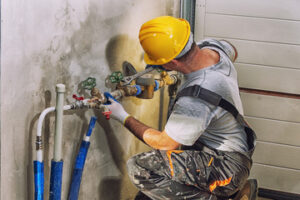Plumbing is the act of conveying fluids in a wide variety of applications. This involves various pipes, valves, plumbing fixtures, and other apparatuses. The most common materials used are metals, including copper, aluminum, steel, and plastics. Other materials are wood, PEX, Acrylonitrile butadiene styrene, and chlorinated PVC.

Wooden pipes have been used for plumbing in the States for centuries. They are considered to be more rot-resistant than cast iron and are better for certain purposes.
Wooden water pipes were commonly used in the states during colonial times. These pipes were made from hollowed-out logs, which were then drilled through the center. The resulting hole would be capped with a wooden plug, and the end would seal in place.
They were considered to be cheaper than cast iron. Engineers in that era also thought that wood was not affected by acids, so they thought it was the best material for pipes.
Some of these pipes were even drilled into for water to fight fires. Although these systems were considered to be less reliable, they were still used throughout the States.
Another type of pipe was the stave pipe. This was made from wood sections that were a few inches thick. When the sections were soaked in water, they formed tight seals.
A stave pipe was usually twelve to 72 inches in diameter. It was made of clear, sound lumber. Stave wood pipes were often sold with a redwood plug marked on one end.
Wooden pipes were sometimes uncovered during construction projects. These are often sliced up as souvenirs or displayed in museums. Despite the deterioration of these wooden water pipes, they are a reminder of the fragility of drinking water systems. They are thought to be fifty to seventy years old.
Galvanized steel plumbing pipes have a long history. They have been used in homes and businesses since before the 1960s. During that time, builders began looking for alternatives to lead pipes.
Even though galvanized piping is still available, it is not recommended for use. The material is not only susceptible to rusting, but it can also contaminate the water that flows through it. This can cause problems with water pressure, discoloration, and other issues.
Luckily, there are ways to prevent problems from occurring in the first place. One such way is to reline the pipes with modern materials. It is a more cost-effective option than replacing the whole pipe.
If you are concerned about your plumbing, it is best to contact a professional plumber. He will be able to identify the problem and make the necessary repairs.
Another option is to reline the pipes yourself. But, if you have a large network of pipes, it might be difficult to clean them by yourself.
You may need to have a professional plumber inspect your plumbing to determine whether or not your system is rusted out. Depending on your insurance policy, it could affect how much you can spend. However, if you do not have insurance coverage, there are steps you can take to protect your plumbing from costly repairs.
Inspect your galvanized steel plumbing pipes for signs of damage. These signs can include rust at the joints, a leak, or uneven water distribution. Some of these signs aren’t visible, but if you see any of them, it is a good idea to have them addressed immediately.
A leaking pipe can result in a lot of damage, including mold and termites. If you find out that your pipe is corroded, you should immediately replace it.
